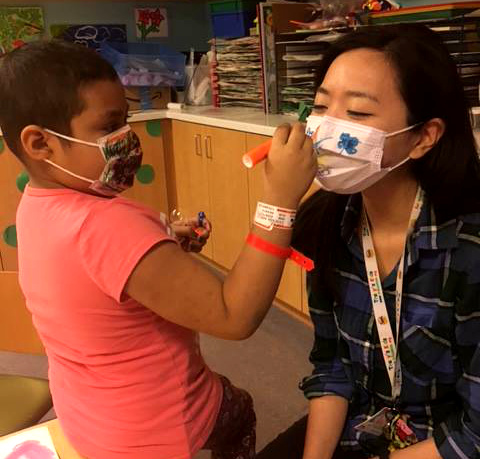ABOUT ART THERAPY
THE ART THERAPY PROFESSION
.
Art therapy is a mental health profession that enriches the lives of individuals, families, and communities through active art-making, creative process, applied psychological theory, and human experience within a psychotherapeutic relationship.
.
Art therapy, facilitated by a professional art therapist, effectively supports personal and relational treatment goals as well as community concerns. Art therapy is used to improve cognitive and sensorimotor functions, foster self-esteem and self-awareness, cultivate emotional resilience, promote insight, enhance social skills, reduce and resolve conflicts and distress, and advance societal and ecological change. Read the full definition.
WHO ARE ART THERAPISTS
Art therapists are clinicians with master’s-level or higher degrees trained in art and therapy that serve diverse communities in different settings—from medical institutions and wellness centers, to schools and independent practices. Guided by ethical standards and scope of practice, their education and supervised training prepares them for culturally proficient work with diverse populations in a variety of settings. They are credentialed mental health care professionals who care deeply about the communities they support, helping to advance people’s mental, emotional, and physical well-being.
WHERE ART THERAPISTS WORK
Art therapists work with individuals, couples, families, and groups in diverse settings. Some examples include:
- Hospitals
- Schools
- Veteran’s clinics
- Private practice
- Psychiatric and rehabilitation facilities
- Community clinics
- Crisis centers
- Forensic institutions
- Senior communities

HOW ART THERAPY WORKS
Through integrative methods, art therapy engages the mind, body, and spirit in ways that are distinct from verbal articulation alone. Kinesthetic, sensory, perceptual, and symbolic opportunities invite alternative modes of receptive and expressive communication, which can circumvent the limitations of language. Visual and symbolic expression gives voice to experience and empowers individual, communal, and societal transformation.
INACCURATE USE OF TERM ‘ART THERAPY’
Inaccurate use of “art therapy” often occurs due to a lack of knowledge about the profession. Such instances provide an opportunity to offer accurate information and educate the public. It is with this in mind that the AATA encourages outreach to individuals and/or companies that may be found to inaccurately categorize activities (such as trainings that are offered by non-art therapists) or products (such as adult coloring books) as “art therapy.”
Additional inquiries can be directed to the AATA at info@arttherapy.org.
EXAMPLE ACTIVITIES
IN ADVERTISING
On occasion, non-art therapist practitioners might be found to advertise their services as “art therapy.” This is an inaccurate use of the term, as art therapy can only be practiced by an individual who possesses the required training, certification, and/or state licensure. Bona fide art therapy is beyond the scope of practice of non-art therapists.
IN WORKSHOPS
Another context in which art therapy may be inaccurately categorized includes professional trainings that furnish a certificate upon completion, which may mislead the participant to believe that he or she can practice art therapy. These sorts of trainings, workshops, and the like, give attendees the erroneous impression that art therapy is a modality rather than a profession.
To prevent this problem, facilitators are advised to adhere to the AATA’s Ethical Principles: “When providing training and/or supervision to non-art therapists, art therapists take precautions to ensure that trainees understand the nature, objectives, expectations, limitations, and resulting qualifications of the supervision and/or training as distinct from formal studies in art therapy” (8.6). As such, a disclaimer should be used to alert attendees accordingly.
EXAMPLE PRODUCTS
Several products on the market may inaccurately identify the term “art therapy.” Two such examples include art therapy apps and art therapy coloring books.
IN ADULT COLORING BOOKS
While the AATA does not discourage the use of coloring books for recreation and self-care, coloring activities must be distinguished from art therapy services provided by a credentialed art therapist. Review the AATA’s official statements for details:
- Art Therapy and Coloring Books: AATA Draws the Line, January 2016
- The Adult Coloring Book Phenomenon, August 2015
For those interested in more information, the following articles provide accurate representations of both art therapy and adult coloring books:
- “Adult Coloring Books: A Safe Space to Play with Color” by Conan Milner for the Epoch Times, February 2016
- “Color Me Cautious: Don’t Mistake Adult Coloring Books for Art Therapy” by John Diconsiglio for the Columbian College of Arts & Sciences, February 2016
- “Adult Coloring Books” (Video) with Dr. Val Huet, the British Association of Art Therapists (BAAT) Chief Executive Officer for Reuters TV, December 2015
ADDRESSING CONCERNS ABOUT REPRESENTATION OR SERVICES
If you encounter an individual who may be erroneously identifying himself/herself as an art therapist, please review “How to Proceed When You Believe Someone is Misrepresenting Him/Herself as an Art Therapist.” Professional credentials in art therapy can be verified through the Art Therapy Credentials Board.

